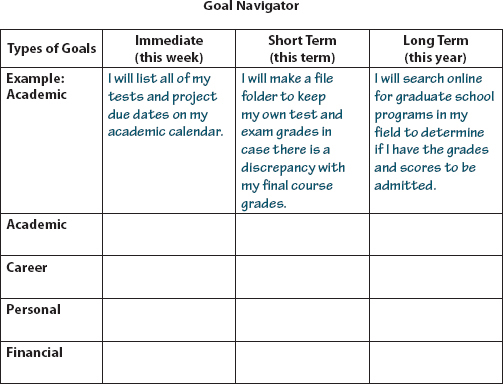Setting Smart Goals
Follow these guidelines to set some short-term goals and consider how they fall within the framework of setting SMART goals: goals that are Specific, Measurable, Attainable, Relevant, and anchored to a Time period.1 (Figure 1.1 gives you a chance to practice.)
- State your goal in measurable terms. Be specific about what you want to achieve and when.
- Be sure the goal is achievable. Allow enough time to pursue it. If you don’t have the necessary skills, strengths, and resources to achieve your goal, modify it appropriately.
- Be sure you genuinely want to achieve the goal. Don’t set out to work toward something only because you want to please others.
- Know why the goal matters. Be sure your goal fits into a larger plan and has the potential to give you a sense of accomplishment.
- Identify difficulties you might encounter. Plan for ways you might overcome obstacles.
- Decide which goal comes next. How will you begin? Create steps and a time line for reaching your next goal.
For instance, let’s assume that after you graduate you think you might want to work in an underdeveloped country, perhaps spending some time in the Peace Corps. What are some short-term goals that would help you reach this long-term objective? One goal might be to take courses focused on different countries or cultures, but that goal isn’t very specific and doesn’t state a particular time period. A much more specific goal would be to take one course each year to help you build a body of knowledge about other countries and cultures. An even more specific goal would be to review the course catalog, identify the courses you want to take, and list them on a personal time line. You could also look for courses that give you the opportunity to engage in service learning, course-based service activities that will give you a taste of the kind of work you might be doing later in an underdeveloped country.
service learning Unpaid volunteer service that is embedded in courses across the curriculum.
You might also want to gain some actual experience before making a final decision about working in other countries. Another intermediate goal could be traveling to other countries or combining the earning of college credits with performing service abroad through an international organization such as the International Partnership for Service Learning. Your goal for this week could be doing an Internet search or visiting your campus study-abroad office to research your options for international travel or service work.

Before working toward any long-term goal, it’s important to be realistic and honest with yourself. Is it your goal—one that you value and desire to pursue—or is it a goal that a parent or friend argued was “right” for you? Given your abilities and interests, is the goal realistic? Remember that dreaming up long-term goals is the easy part. You need to be very specific and systematic about the steps you will take today, this week, and throughout your college experience to reach your goals.